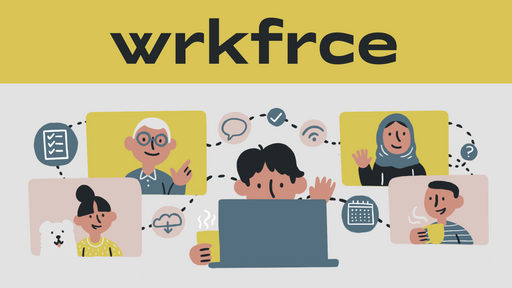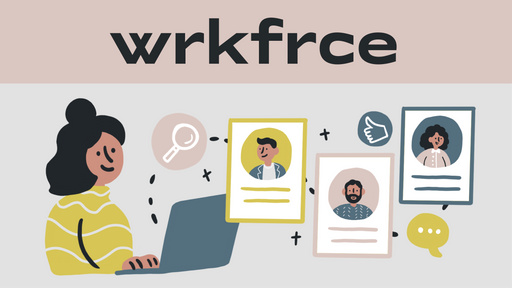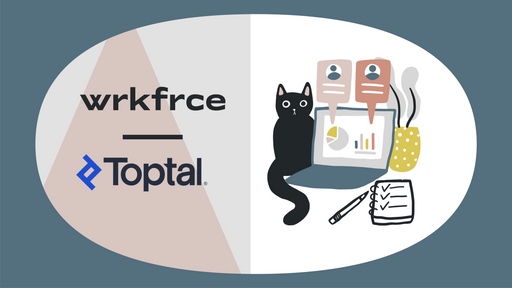Summary: InVision’s Remote Playbook
by Sarah Archer

The global rise of reactive remote work in 2020 spawned a proliferation of playbooks published by many of the leading remote-first companies, which open-sourced the knowledge they’ve gained from years of successful fully remote operation to help other businesses follow their lead. There’s only one problem: These playbooks are loooooong. So wkrfrce has condensed them into abridged versions—CliffsNotes, if you will. Digital nomad Sarah Archer, a passionate advocate of remote and flexible work, has combed through thousands of pages of remote-first strategies to deliver the most unique, most useful, most actionable insights to help make working remotely work for you.
When Clark Valberg and Ben Nadel launched InVisionApp in 2011, they set out to deliver the best possible digital product experience. People quickly caught on.
The design platform took fewer than 10 years to grow an international presence of more than 7 million users.
InVision helps designers manage people and workflow in real time, and it has become a fundamental collaboration product for engineering, product, and marketing teams.
True to how its product supports teams around the globe, InVision believes that outcomes come from people, not places. One of the largest completely distributed companies spread across 20 countries, company shared its actionable advice for running a successful remote company, which we summarize here.
People Come First, Work Second
Intentionally taking care of employees always has been and always will be InVision’s foundation.
People are the most important part of any company. Leadership’s role is to help them feel better, stronger, and smarter. Below are InVision’s approaches to doing just that.
- Don’t skip meaningful rituals
It’s easy to delay a regular meeting with a direct report, but don’t. These connection rituals are essential to your team members. InVision locks in 1:1s at least one quarter ahead to show commitment to and concern for each member’s career and well-being. And it maintains a living document that shares all goals, objectives, and decisions. - Never start with work
To illustrate your commitment to your people, spend 5 to 10 minutes at the beginning of each call to ask participants how they’re doing. - Use Slack strategically
Maintain threads with each designer to share interesting content or make a work-appropriate joke, but don’t use Slack to replace check-ins. Face-to-face (or at least screen-to-screen) time ensures remote employees have regular access to you. - Get personal
Meetings don’t have to be all work and no play. You can connect personally with team members by asking about their family, pets, hobbies, and more. The goal is to develop the same connection you would have if you were working alongside them. - Connect socially
InVision encourages playing games like World of Warcraft, Mario Kart, or Pictionary, or joining a cooking challenge. Get creative about ways to enjoy virtual time with coworkers outside of work. - Celebrate birthdays
Just because you can’t share cupcakes in the break room doesn’t mean you can’t celebrate a team member’s birthday. InVision employees draw and write virtual good wishes using Freehand. - Be empathetic
Working from home means that people often restructure their schedules to manage their household, take care of children, or run important errands. You can support your team by being understanding and supportive. - Build a strong culture
A key InVision cultural value is establishing trust and psychological safety throughout the company. This value ensures that employees feel comfortable taking risks without feeling insecure or embarrassed.
Develop a Communication and Collaboration Strategy That Sticks
Remote collaboration and communication are at the core of InVision’s product and people, and the company pursues these strategies deliberately, not by happenstance.
Rebecca Kerr, principal content strategist at InVision, said, “When you’re collaborating remotely, if you want it to work, there has to be an agreement on how you are going to communicate.”
From the very beginning, identify the channels your team will use to communicate with each other, partners, and customers. Then consider these communication and collaboration must-haves that InVision champions.
- Invest in a digital ideation tool
Replace whiteboards and sticky notes with a design tool that’s simple and accessible, and that facilitates creative freedom. InVision recommends its Freehand tool, which allows teams to collaborate in real time. - Put RACI into practice
Strive to live by the RACI model (Responsible, Accountable, Consulted, and Informed) to decide who needs to attend a meeting and who can be consulted separately instead. - Foster creativity
Designers thrive in a curious, creative, collaborative, and energetic environment. You can foster that remotely by introducing a show-and-tell and promoting eight-hour design sprints. - Get inspired by others’ stories
Encourage your team to read case studies or books that will help them develop their work. InVision designers read “Steal Like an Artist,” “Show Your Work,” and “Keep Going: 10 Ways to Stay Creative in Good Times and Bad,” and discuss them in a dedicated weekly meeting. - Schedule design critiques
The InVision team sets aside a weekly one-hour critique. Design managers lead but other department members can participate. All sessions require that attendees turn on their video, ask questions, and provide feedback. InVision also records all critiques so designers can focus on listening (and responding, if needed) and don’t need to take notes or document. - Share and promote work
Use digital tools to share work internally and externally. Promote your team’s work in a newsletter, create case studies, add it to executive briefs, and encourage team members to present their work on video calls. - Set up open-ended video sessions
To mimic the feel of working alongside colleagues, InVision encourages setting up a video call on an iPad or second screen and keeping it on so people can “wander in” to your “office” for a chat. - Pick a few collaboration tools
More tools aren’t better—narrow your options to a powerful, purposeful tool kit that facilitates collaboration. InVision swears by Zoom, Freehand, Slack, and Google Docs. - Invite executives to projects
If getting approval from stakeholders is important, include them in discussions about a project so they better understand your team’s process and can advocate for your design. - Write a playbook
InVision obviously follows its own advice here. The company documents the repeatable processes, activities, and tools available to its design teams. InVision also organizes its playbook using an easy-to-follow table of contents and creates easy access to essential information via links.
Use Documentation to Drive Effective Remote Work
Imagine that a key employee unexpectedly needs to take time away from work. Is your team prepared to pick up where they leave off?
If not, then you must improve your process for documenting operational structure, decisions, projects, and roles so your team doesn’t miss a beat. InVision’s actions to develop robust documentation include the following:
- Centralize resources
InVision’s directory is accessible to all and maps out architecture, naming conventions, and automatic backup schedules. This information makes it easy for everyone to follow and pin the map in team Slack channel for quick reference. Anytime a process changes, InVision quickly updates documents. - Schedule file purges
To back up all files and to keep working file storage clear, InVision teams regularly clean local drives and move files to cloud-based storage. - Manage expectations for designers and developers
To determine the best ways to hand off a design to developers, early in the project InVision uses a tool like Inspect to set delivery expectations. - Build social agreements for every role
How? Listen to what’s important to different departments, what they think is important to you, and how the company measures their work. Use those insights to shape agreement on how each role should work with the others. - Streamline onboarding
Onboarding new hires has traditionally meant filling out tax forms and selecting insurance options. Those are important, of course, but providing context and instructions for new hires, including company background (industry, company, business unit, and team) is even more essential. InVision uses the onboarding program Xenia to walk every employee through the same onboarding process, making it both streamlined and consistent.
Hold Purposeful and Actionable Meetings
In the absence of the interaction that naturally occurs in an onsite office, meetings for a distributed workforce must be deliberate and purposeful. Consider these InVision practices to for making meetings focused and actionable.
- Appoint a meeting leader
This person sets the tone and ensures a successful meeting. The leader’s tasks are to plan, test tools, complete a dry run of activities, and set up Zoom breakout groups ahead of time. - Approach meetings from an attendee perspective
Effective meetings ensure everyone feels important. InVision advises: Help the meeting leader, invite and listen to everyone, and don’t dominate the conversation. Try using a tool like Poll Everywhere to get feedback on larger meetings in real time. - Always use an agenda
Make sure all meeting attendees have access to and can comment on an agenda beforehand. In this way, everyone can contribute and be heard, even if they aren’t comfortable speaking in front of a large group of people. - Document a weekly path
InVision creates a document for direct reports and their managers to share weekly updates on their main area of focus, what’s going well, and any questions or topics to discuss during meetings. They then use these documents as the meeting agenda and recap. - Ensure quality audio and video connection
For video meetings, encourage participants to turn turn on their video to ensure everyone is engaged and attentive, and ask them to mute themselves when they’re not speaking, to decrease background noise. If you have a low-bandwidth connection, use your phone. - Pay attention to your body language
Make sure your body language doesn’t conflict with your verbal message. Make eye contact, smile, and relax your shoulders. Your calm nonverbal communication will help everyone feel more comfortable. - Create weekly design challenges
InVision encourages teams to expand their comfort zone by starting meetings with a 10-minute design challenge. This exercise pushes designers to think beyond their typical design practice and industry and look for new ideas. - Consider your setup
InVision encourages workers to be visible on video and knows they want to project a positive image. The company encourage employees to put the light in front of them, mute when typing, wear a headset, and keep their visible workspace neat and clean. Some people even curate their backdrop to reflect their personality.
Taking care of people, communicating and collaborating effectively, empowering workers to think outside the box, and making sure all workers feel heard and respected. That’s the advice from a company now valued at $1.9 billion with no physical headquarters. They know how to make remote work, work.
Learn how other teams approach working remotely through our remote playbook series.









